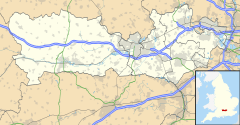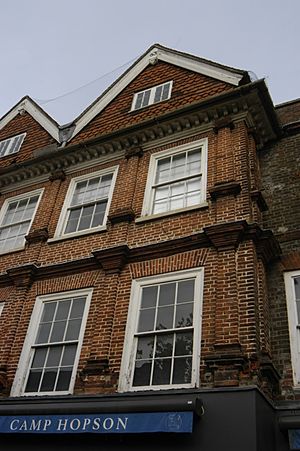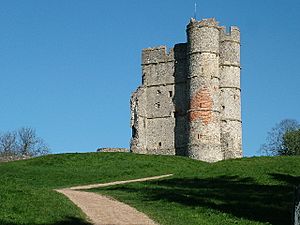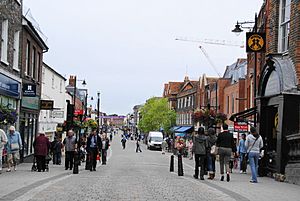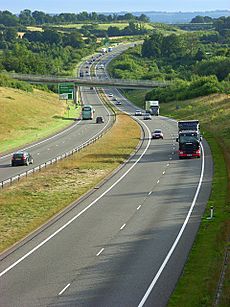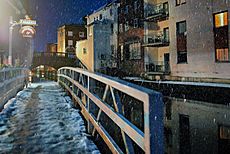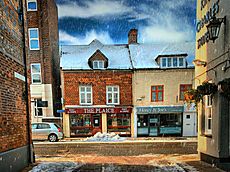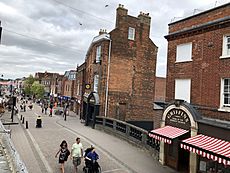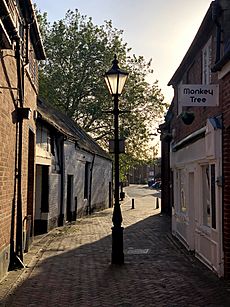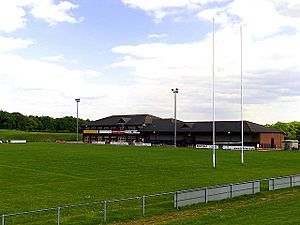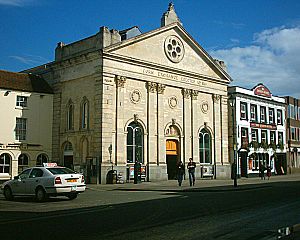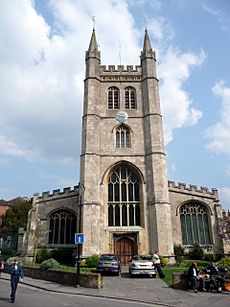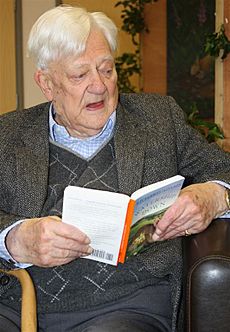Newbury, Berkshire facts for kids
Quick facts for kids Newbury |
|
|---|---|
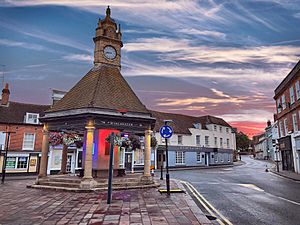 Newbury clock tower at sunset in 2018 |
|
 Flag |
|
| Area | 9.9 km2 (3.8 sq mi) |
| Population | 41,075 |
| • Density | 4,149/km2 (10,750/sq mi) |
| OS grid reference | SU4767 |
| • London | 60 mi (100 km) |
| Civil parish |
|
| Unitary authority |
|
| Ceremonial county | |
| Region | |
| Country | England |
| Sovereign state | United Kingdom |
| Post town | NEWBURY |
| Postcode district | RG14 |
| Dialling code | 01635 |
| Police | Thames Valley |
| Fire | Royal Berkshire |
| Ambulance | South Central |
| EU Parliament | South East England |
| UK Parliament |
|
Newbury is a market town in the county of Berkshire, England, which is home to the administrative headquarters of West Berkshire Council. The town centre around its large market square retains a rare medieval Cloth Hall, an adjoining half timbered granary, and the 15th-century St Nicolas Church, along with 17th- and 18th-century listed buildings. As well as being home to Newbury Racecourse, it is the headquarters of Vodafone and software company Micro Focus International. In the valley of the River Kennet, 26 miles (42 kilometres) south of Oxford, 25 mi (40 km) north of Winchester, 27 mi (43 km) southeast of Swindon and 20 mi (32 km) west of Reading.
Newbury lies on the edge of the Berkshire Downs; part of the North Wessex Downs Area of outstanding natural beauty, 3 mi (5 km) north of the Hampshire-Berkshire county boundary. In the suburban village of Donnington lies the part-ruined Donnington Castle and the surrounding hills are home to some of the country's most famous racehorse training grounds (centred on nearby Lambourn). To the south is a narrower range of hills including Walbury Hill and a few private landscape gardens and mansions such as Highclere Castle. The local economy is inter-related to that of the eastern M4 corridor, which has most of its industrial, logistical and research businesses close to Newbury, mostly around Reading, Bracknell, Maidenhead and Slough. Together with the adjoining town of Thatcham, three miles (four point eight kilometres) distant, Newbury forms the principal part of an urban area of approximately 70,000 people.
Contents
History
There was a Mesolithic settlement at Newbury. Artefacts were recovered from the Greenham Dairy Farm in 1963, and the Faraday Road site in 2002. Additional material was found in excavations along the route of the Newbury Bypass.
Newbury was founded late in the 11th century following the Norman conquest as a new borough, hence its name. Although there are references to the borough that predate the Domesday Survey it is not mentioned by name in the survey. However, its existence within the manor of Ulvritone is evident from the massive rise in value of that manor at a time when most manors were worth less than in Saxon times. In 1086 the Domesday Book assesses the borough as having land for 12 ploughs, 2 mills, woodland for 25 pigs, 11 villeins (resident farmhands, unfree peasant who owed his lord labour services), 11 bordars (unfree peasants with less land than villans/villeins), and 51 enclosures (private parks) rendering 70s 7d.
Doubt has been cast over the existence of 'Newbury Castle', but the town did have royal connections and was visited a number of times by King John and Henry III while hunting in the area.
Historically, the town's economic foundation was the cloth trade. This is reflected in the person of the 16th century cloth magnate, Jack of Newbury, the proprietor of what may well have been the first factory in England, and the later tale of the Newbury Coat. The latter was the outcome of a bet as to whether a gentleman's suit could be produced by the end of the day from wool taken from a sheep's back at the beginning. The local legend was later immortalized in a humorous novel by Elizabethan writer Thomas Deloney.
Newbury was the site of two battles during the English Civil War, the First Battle of Newbury (at Wash Common) in 1643, and the Second Battle of Newbury (at Speen) in 1644. The nearby Donnington Castle was reduced to a ruin in the aftermath of the second battle.
The disruption of trade during the civil war, compounded by a collapse of the local cloth trade in the late 16th century, left Newbury impoverished. The local economy was boosted in the 18th century by the rise of Bath as a popular destination for the wealthy escaping London's summer heat and associated stench. Newbury was roughly halfway between London and Bath and an obvious stopping point in the two-day journey. Soon Newbury, and the Speenhamland area in particular, was filled with coaching inns of ever increasing grandeur and size. One inn, the George & Pelican, was reputed to have stabling for 300 horses. A theatre was built to provide the travellers with entertainment featuring the major stars of the age. In 1795 local magistrates, meeting at the George and Pelican Inn in Speenhamland, introduced the Speenhamland System which tied parish poor relief (welfare payments) to the cost of bread.
The opening of the Great Western Railway to the north of Newbury effectively killed the coaching trade. Having been approximately midway on the Bath Road from London, Newbury became something of a backwater market town, with an economy based largely on agriculture and horse-racing. In the 1980s, British electronics firm Racal decided to locate their newly formed telecommunications company Racal Vodafone (later Vodafone UK) in the town. In the subsequent decades Newbury became something of a regional centre for the high-tech industries, and the town has since enjoyed a return to general economic prosperity.
Greenham Common
A large Royal Air Force station was established during the Second World War at Greenham Common on the edge of the town. In the 1950s, it became home to US Air Force bombers and tankers, for which it was equipped with the longest military runway in the United Kingdom. In the 1980s, it became one of only two USAF bases in the UK equipped with ground-launched nuclear-armed cruise missiles, causing it to become the site of protests by up to 40,000 protesters and the establishment of the Greenham Common Women's Peace Camp. With the end of the Cold War, the base was closed, the runway was broken up for use as fill material in building the Newbury bypass, and much of the area was restored to heathland.
Geography
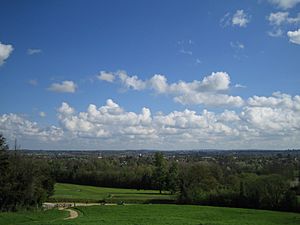
The Civil Parish of Newbury consists of the town and the suburbs of Wash Common, the City, West Fields, East Fields and Speenhamland. The modern conurbation of Newbury, however, with close bus and road links and almost contiguous development, may be taken to include the surrounding villages of Speen, Donnington, Shaw and Greenham.
Elevations vary from a minimum of 72m above mean sea level to 122m at Wash Common. Elevations reach 150-200m in the directly adjoining hills.
The River Kennet and the Kennet and Avon Canal flow east through the centre of the town to reach the Thames at Reading, while the River Lambourn (beside which is the country's largest horse-training paddocks in the Valley of the Lambourn Downs) partly forms its northern boundary, ending in the town. A tributary that is smaller still, the River Enborne, forms the southern boundary (and also the county boundary with Hampshire). Adjoining the town's south-eastern border is Greenham Common and the famous Newbury Racecourse. Newbury is surrounded on three sides (north, west and south) by the North Wessex Downs Area of Outstanding Natural Beauty. The downland to the south rises steeply out of the river valley providing scenic views, including Watership Down (made famous by the novel of the same name), Beacon Hill, the southeast's highest point Walbury Hill, and Combe Gibbet.
Demography
Newbury has two very narrowly buffered settlements, Thatcham (25,267 inh. as at 2011) and Shaw cum Donnington (1,686 inh. as at 2011) forming an identifiable, informal greater Newbury urban and suburban conglomeration. In major use classes 11% of Newbury's land is occupied by roads and as of 2005, 34% of its land was occupied by domestic gardens.
| Output area | Homes owned outright | Owned with a loan | Socially rented | Privately rented | Other | km2 roads | km2 water | km2 domestic gardens | Usual residents | km2 |
|---|---|---|---|---|---|---|---|---|---|---|
| Civil parish | 3816 | 4549 | 2589 | 2464 | 133 | 1.146 | 0.189 | 3.430 | 41075 | 9.9 |
Transport
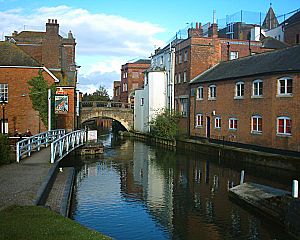
Newbury spans the River Kennet, the valley of which has for millennia formed an important east–west transport route, served by the Kennet and Avon Canal, and the Reading to Taunton Line, one of three routes from London to West Country.
Rail
Today, Newbury is served by two railway stations, Newbury and Newbury Racecourse, which both lie on the Reading to Taunton line. It was also served by the Didcot, Newbury and Southampton Railway until this closed in the 1960s.
Road
Following a similar east–west route is the A4 road from London to Bristol, historically the main route west from London. This road has been superseded as a long-distance route by the M4 motorway which runs almost parallel and can be accessed three miles (five kilometres) to the north. Its "Newbury junction" is the Chieveley interchange at Junction 13. At Newbury this east–west route is crossed by a dual-carriageway north–south trunk road, from the major south coast port of Southampton to the industrial centres of the Midlands. Although this route was once served by the Didcot, Newbury and Southampton Railway, today it is only served by the A34 road, which now bypasses Newbury to the west on an alignment partially using the old rail route (see also 'Newbury Bypass' below).
Until the completion of the bypass, the A34 and A4 met in the town centre at Robin Hood Roundabout, a complicated gyratory system encompassing 6 approaching roads, a fire station, ambulance station and an exit on the inside of the roundabout, which has a north–south flyover across the roundabout. In 2007, the sculpture Couple in Conversation was unveiled on the roundabout, providing a new landmark for one of the major gateways into the town. Other significant roads radiating from Newbury include the A339 which now includes the renumbered part of the old A34 through the town centre and then heads towards Basingstoke and the M3 motorway, the A343 to Andover, the B4000 to Lambourn, the B4494 to Wantage and the B4009 to Streatley.
Bus services
Most local bus services were provided by Newbury Buses, a division of Reading Buses before August 2011. This was when they were transferred to private companies (The Link and route 7 remain in private hands, operated by Stagecoach South, with West Berkshire Connect also operating a couple of services), with the main operator being Weavaway Travel, trading as Newbury & District. However, West Berkshire Council contracted services were transferred back to Reading Buses, who continue to operate the Vodafone Buses and the Jet Black 1 service (initially alongside Weavaway), under the Kennections brand in September 2016. 2 years later, in September 2018, they also acquired Newbury & District from Weavaway.
Newbury bypass
The town's location at the intersection of the routes from London to Bristol and from Southampton to Birmingham made it, for many years, a transport bottleneck. In 1963 a Dual Carriageway was built east of the town centre to ease congestion and the opening of the M4 motorway in 1971 moved the intersection of these major trunk routes three miles (five kilometres) north of the town, to Chieveley. The ring road around the town still suffered serious congestion and the Newbury bypass was proposed in 1981. The plans were approved in 1990.
However they were extremely controversial and this led to a major environmentalist campaign opposing the road development (dubbed the Third Battle of Newbury by parts of the national media). In spite of this, the road was built and finally opened in 1998. Within two months the road surface began to break up and the entire length of the bypass was eventually resurfaced over two weekends using an improved low-noise water-absorbent surface. In August 2004, the improved A34-M4 junction 13 was re-opened which allowed north–south traffic on the A34 road to completely bypass the earlier roundabout at the M4. This junction continued to be improved, with new road markings and traffic signals completed in 2008.
Sports and leisure

Newbury is home to one of England's major racecourses Newbury Racecourse, which celebrated its centenary in 2005. The most prestigious race in the calendar is the Hennessy Gold Cup which normally takes place in late November. Newbury has one of the last remaining lidos in the United Kingdom. It was originally built in the 1890s, although the structure we see today was erected in the 1930s. The pool is still in use today and is capable of receiving more than 1000 visitors a day during peak times. It is owned and subsidised by West Berkshire Council but managed by an external contractor Parkwood Leisure.
Newbury's rugby union club, Newbury R.F.C. (also sponsored by Vodafone), is based in the town. In the 2004/05 season, the club finished second in the National Two division earning promotion to National One and is now in the top 26 clubs nationally. Newbury had previously won National Four South (now renamed as National Three South) in 1996/97 with a 100% win record. The club was founded in 1928 and in 1996 moved to a new purpose-built ground at Monks Lane, which has since hosted England U21 fixtures. Cricket clubs in the town include Newbury Cricket Club (situated right in the town centre) and Falkland CC. Newbury also has two athletics clubs: Team Kennet and Newbury Athletics Club. Newbury District Leagues exist in many other sports such as badminton, table tennis, squash and darts.
Newbury was home to A.F.C. Newbury, which was sponsored by locally based Vodafone. In May 2006 Vodafone ended its sponsorship of the club, following which the club collapsed. A local pub team from the Old London Apprentice took over the ground temporarily and now compete in the Reading League as Newbury F.C. Their future at the ground is uncertain as the owner (West Berkshire Council) plans to turn it into a car park. Victoria Park, near the centre of the town, is used for several events during the year such as the Newbury Waterways Festival, the Keep Off The Grass (KOTG) dance music event and Crafty Craft, an improvised raft race along the canal.
As well as lending out books, Newbury Library, which moved to a new building in July 2000, provides internet access and other services to its users and members. The Corn Exchange provides a venue for both professional and amateur live performances. Other theatres near the town are the Watermill Theatre, and New Greenham Arts on the former Greenham Common air force base. Annually the Newbury Spring Festival of classical music brings internationally renowned soloists and ensembles to a variety of venues in and around the town. The Newbury Comedy Festival which started in 2004 has become a feature in the town's cultural calendar. Newbury is also home to the Donnington Grove estate, where a golf course was opened in 1993. The Donnington Grove mansion, built between 1763 and 1772, is a local historic landmark.
Places of interest
- 'The Corn Exchange' – theatre and cinema
- Kennet and Avon Canal shop and tearooms
- West Berkshire Museum
- Jack of Newbury’s House
- St Nicolas' Church (CofE), completed in 1532. This is a fine example of a parish church built entirely in the Perpendicular style.
- St Bartholomew's Hospital (almshouses)
- The Litten Chapel
- The Falkland Memorial
- Donnington Castle
- Nearby places of interest include Bucklebury Farm Park, Combe Gibbet, Highclere Castle, the Sandham Memorial Chapel, The Nature Discovery Centre, the Watermill Theatre and Watership Down.
- New Greenham Arts – an ex-US military building on Greenham Common airbase, now used to house artist studios, and a performing arts centre.
- Disused GAMA and control tower at Greenham Common.
Economy
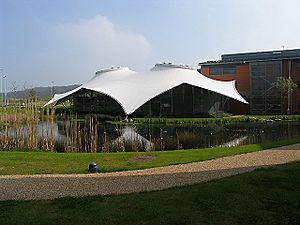
Newbury and its immediate surroundings constitute the major commercial and retail centre of West Berkshire. The local economy is inter-related to that of the eastern M4 corridor which has most of its industrial, logistical and research businesses close to Newbury, Reading and Slough, with smaller industrial estates in the county at Theale, Bracknell and Maidenhead. Newbury is home to the United Kingdoms headquarters of the mobile network operator Vodafone, which is the town's largest employer with over 6,000 workers. Before moving to their £129 million headquarters in the outskirts of the town in 2002, Vodafone used 64 buildings spread across the town centre.
As well as Vodafone, Newbury is also home to the United Kingdom headquarters of National Instruments, Micro Focus, Stryker Corporation, Grass Valley (formerly Snell Advanced Media which was formerly Quantel), Cognito, EValue and Newbury Building Society. The pharmaceutical company Bayer AG are also headquartered in the town, although in October 2015 the company announced their intention to move to the Green Park Business Park near Reading.
Education
Newbury has three main secondary schools:
- St. Bartholomew's School – one of the oldest schools in Berkshire, founded in 1466.
- Park House School
- Trinity School, formed after the closure of Shaw House School and Turnpike School.
There is also Newbury College, a further and higher education college funded by a private finance initiative and Mary Hare School, a residential co-educational community special needs school for deaf pupils.
Independent schools nearby include:
- Horris Hill, an all-boys day and boarding school (from ages 4 to 13; boarding from 7 to 13)
- Downe House School
- Cheam School
- St Gabriel's School, an all-girls school (from the ages 3 to 18)
- Thorngrove School, a day co-ed school in nearby Highclere (from the ages 2½ to 13)
- Newbury Hall School, an international high school
- St Michael's School, a Roman Catholic school in Burghclere
Notable people
A number of notable people have originated from, worked, lived or died in Newbury:
- Richard Adams (1920–2016) – author
- Hannah Aldworth (?–1778) – philanthropist
- Roger Attfield (1939–) – thoroughbred horse trainer
- Francis Baily (1774–1844) – astronomer
- Captain Collet Barker (1784–1831) – early Australian explorer
- Michael Bond (1926–2017) – creator of Paddington Bear
- Harry Bowl (1914–?) – footballer
- Bruno Brookes (1959–) – radio and television presenter
- Lord Carey (1935–) – former Archbishop of Canterbury
- Lawrence Chaney (1996–) – drag performer
- Simon Channing-Williams (1945–2009) – film producer
- Keith Chegwin (1957–2017) – television presenter
- Harry Cotterell (1841–1925) – British trader
- Miles or Myles Coverdale (1488–1569) – bishop, co-author of the 1st English Bible
- George Dangerfield (1904–1986) – journalist and author
- Sebastian Faulks (1953–) – author
- Gerald Finzi (1901–1956) – composer and founder of the Newbury String Players
- Jill Fraser (1946–2006) – Watermill Theatre owner and director
- William Henry Gore (1857–1942) – painter of the Berkshire countryside, born and died in Newbury.
- James Hanson, Lord Hanson (1922–2004) – haulier, later venture capitalist
- Alec Hopkins (1986–) – actor who played the young Severus Snape in Harry Potter and the Order of the Phoenix
- Sir Michael Hordern (1911–1995) – actor
- Luke Humphries (1995–) – professional darts player
- John Kendrick (1573–1624) – philanthropic patron of the town of Reading
- Edwin Lewis (1881–1959) – Methodist theologian
- William Marshal "The Marshal" seen as first Lord Marshal – (1147–1219) medieval knight given up as a hostage at 'Newbury Castle'
- Jack O'Newbury (1489–1557) – cloth merchant and patron
- John Septimus Roe (1797–1878) – the first Surveyor-General of Western Australia
- "Lord" George Sanger (1825–1911) – circus owner born in Newbury who gave the Queen Victoria statue to the town in 1902
- Hannah Snell (1723–1792) – female soldier
- Edward C. ('Ted') Titchmarsh (1899–1963) – leading 20th-century theoretical mathematician
- Theo Walcott (1989–) – footballer, originally for A.F.C. Newbury. Currently plays as a forward for Southampton, previously played for Arsenal and Everton
- Sir Frank Williams (1942–2021) – Formula One manager, founded the WilliamsF1 team
Nobles killed at the First Battle of Newbury
See also
 In Spanish: Newbury para niños
In Spanish: Newbury para niños


